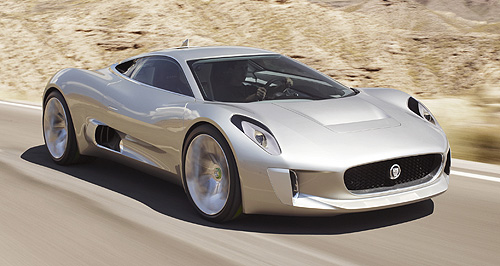Make / Model Search
Future models - Jaguar - C-X75Production Jaguar C-X75 to get screaming 1.6 turboLike a banshee: The tiny but potent four-cylinder engine reportedly developed for the Jaguar C-X75 is said to rev out to some 10,000rpm. Plug-in Jaguar C-X75 supercar to feature ballistic 375kW twin-charged 1.6 engineGallery Click to see larger images 25 Jul 2012 JAGUAR has revealed that the plug-in hybrid drivetrain in its forthcoming C-X75 supercar will feature a remarkable F1-inspired 1.6-litre twin-charged four-cylinder petrol engine with around 375kW of power and a remarkable 10,000rpm redline when it hits the road within three years. The company previewed the new engine – reportedly developed in-house – to UK motoring media this week, ahead of the car’s limited 200-unit production run set for 2014. It is expected to be priced at around £900,000 ($A1.35 million). The turbocharged and supercharged engine will supplement an electric motor placed on the rear axle, either driving the rear wheels directly or charging the batteries. A fast-acting supercharger will provide boost at low revs, with the turbo kicking in further up the rev band. A separate electric motor located at the front will provide constant power flow to the front wheels via a separate transmission, giving the C-X75 all-wheel drive. It may not be quite as radical as the pair of lightweight gas turbines found on Jaguar’s original concept car from the 2010 Paris motor show, but the projected performance figures suggest the production car will be even faster. Jaguar told the British media that the powertrain has entered the working prototype stage, and is confident of a sub-3.0-second 0-100km/h sprint time and fuel consumption as low as 4.0 litres per 100km. By contrast, the original C-X75 concept’s powertrain – consisting of a 145kW/400Nm electric motor on each wheel and two gas turbines producing 70kW at a constant 80,000rpm – had a claimed sprint time of 3.4 seconds. Thanks to its large battery pack – said to be the heaviest component of the car at around 200kg – the production model is projected to have a pure electric range of 60km, and be able to dash to 100km/h in around 6.0 seconds on electric power alone. These figures would put the C-X75 in the same performance ballpark as Porsche’s forthcoming and equally expensive 918 plug-in hybrid, but unlike this car the Jaguar is confirmed for right-hand-drive production, allowing it to potentially grace Australian roads. According to Autocar, the mid-mounted engine will have both direct and port-fed fuel injection and will sit flush with the centrally located, liquid-cooled 600-volt battery pack. Power will be delivered to the rear wheels via a seven-speed automated manual transmission, rather than a heavier dual-clutch unit. As previously revealed, the car will feature extensive use of carbon-fibre, with the lightweight material used on the chassis, most body panels and the rear sub-frame. The overall structure is said to have been created in conjunction with the Williams Formula One team, with Jaguar said to enjoy direct access to the team’s facilities. It is also interesting to note that Formula One is set adopt 1600cc turbocharged engines in the near future, albeit of the six-cylinder variety. Autocar says the exterior design of the finished product will closely resemble Jaguar’s sleek and low-slung Paris concept. GoAuto reported in October last year that the company had received expressions of interest from two cashed-up Australian fans, and Jaguar Australia brand manager Kevin Goult today confirmed that this was still the case. “We still have people interested,” he said. “The two potential prospects are still around they will be talked to.” Mr Goult said the limited run of 200 cars globally had “pretty much been snapped up”, meaning the two prospective buyers were likely to be the only Australians in with a shot of buying the car new. The upcoming Jaguar and Porsche might be just the start of a trend when its comes to hyper-power hybrid supercars, with Ferrari also reportedly developing a petrol-electric powertrain for an Enzo-replacing flagship. The Italian car-maker displayed an updated version of its hybrid kinetic energy recovery system (Hy-KERS), designed to fit around a V12 engine with a mid-rear installation, at the Beijing motor show in April. At the slightly more affordable (and tamer) end of the scale, BMW will put its long-awaited i8 plug-in supercar into production next year, with similar radical styling to the concept and a likely 0-100km/h sprint time of less than five seconds.  Read more26th of March 2012  Porsche’s $1.3 million ‘hack’918 hybrid supercar ‘mule’ put through its paces by Porsche to show off its moves11th of October 2011  Aussies jag super-catJaguar’s scorching million-dollar C-X75 hybrid supercar draws at least two AussiesAll future models Alfa Romeo Alfa Romeo Abarth Abarth Alpine Alpine Alpina Alpina Audi Audi Aston Martin Aston Martin BMW BMW Bentley Bentley Chery Chery Brabham Brabham Chrysler Chrysler Chevrolet Chevrolet Cupra Cupra Citroen Citroen DS DS Dodge Dodge Fiat Fiat Ferrari Ferrari Foton Foton Ford Ford Great Wall Great Wall FPV FPV Haval Haval GWM GWM Honda Honda Holden Holden Hummer Hummer HSV HSV Infiniti Infiniti Hyundai Hyundai Jaguar Jaguar Isuzu Isuzu Kia Kia Jeep Jeep Land Rover Land Rover Lamborghini Lamborghini Lexus Lexus LDV LDV Mahindra Mahindra Lotus Lotus Mazda Mazda Maserati Maserati Mercedes-AMG Mercedes-AMG McLaren McLaren MG MG Mercedes-Benz Mercedes-Benz Mitsubishi Mitsubishi Mini Mini Opel Opel Nissan Nissan Peugeot Peugeot Pagani Pagani Proton Proton Porsche Porsche Renault Renault Ram Ram Rover Rover Rolls-Royce Rolls-Royce Skoda Skoda Saab Saab SsangYong SsangYong Smart Smart Suzuki Suzuki Subaru Subaru Toyota Toyota Tesla Tesla Volvo VolvoMotor industry news |
Click to shareJaguar modelsResearch Jaguar All future models Alfa Romeo Alfa Romeo Abarth Abarth Alpine Alpine Alpina Alpina Audi Audi Aston Martin Aston Martin BMW BMW Bentley Bentley Chery Chery Brabham Brabham Chrysler Chrysler Chevrolet Chevrolet Cupra Cupra Citroen Citroen DS DS Dodge Dodge Fiat Fiat Ferrari Ferrari Foton Foton Ford Ford Great Wall Great Wall FPV FPV Haval Haval GWM GWM Honda Honda Holden Holden Hummer Hummer HSV HSV Infiniti Infiniti Hyundai Hyundai Jaguar Jaguar Isuzu Isuzu Kia Kia Jeep Jeep Land Rover Land Rover Lamborghini Lamborghini Lexus Lexus LDV LDV Mahindra Mahindra Lotus Lotus Mazda Mazda Maserati Maserati Mercedes-AMG Mercedes-AMG McLaren McLaren MG MG Mercedes-Benz Mercedes-Benz Mitsubishi Mitsubishi Mini Mini Opel Opel Nissan Nissan Peugeot Peugeot Pagani Pagani Proton Proton Porsche Porsche Renault Renault Ram Ram Rover Rover Rolls-Royce Rolls-Royce Skoda Skoda Saab Saab SsangYong SsangYong Smart Smart Suzuki Suzuki Subaru Subaru Toyota Toyota Tesla Tesla Volvo VolvoMotor industry news |





























Facebook Twitter Instagram